|
|
|
|
|
|
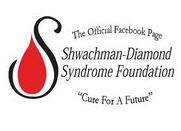
Our New, Official Facebook page! |
|
|
|
| Happy Spring! | | AAHHH, Summer! It is a time that I can sit back and think about SDSF as a whole because July (on the off year that we don't go to Camp Sunshine like this year) is usually quieter in the world of SDS. I can think about what we have been doing, how we can improve and how we can chart a course to where we want to go. The 6th bi-annual SDS Scientific Congress that I just attended has given me much hope for the future for SDS patients and their families
and has provided me much food for thought on how we can take the next steps towards better treatments and possibly cures.
I had a very positive meeting with 9 of our now 10 Medical Advisory Board members directly after the Congress. We discussed the future direction that SDSF needs to pursue in order to reach our goals to find better treatments and cures. With future results to come from the exciting discoveries presented at the Congress, we are that much closer to being able to possibly initiate discussions with biotech and drug companies about creating new therapies. Very exciting!!!!!! All it takes is a ton of money and time!
Last but not least, SDSF will be sponsoring it's annual fundraising campaign starting this September through December. The funds will go towards paying for Camp Sunshine Summer 2012. For those who don't know, per the request of the Camp, SDSF pays/donates $10,000 or more for our week-long stay. SDSF also pays travel and lodging for the 5-8 doctors and scientists who we fly in for 2 days to present informational seminars which typically amounts to an extra $5,000. So start thinking about how you can raise money for our next year's stay at Camp Sunshine. More details to follow in a separate email in August. Of course, if we reach our goal of $15,000, we will apply the extra funds towards research! Both are vital for our SDS community.
Have a nice rest of the summer.
Peace,
Blair Van Brunt, President SDSF |
|
6th Bi-Annual Scientific Congress report
| 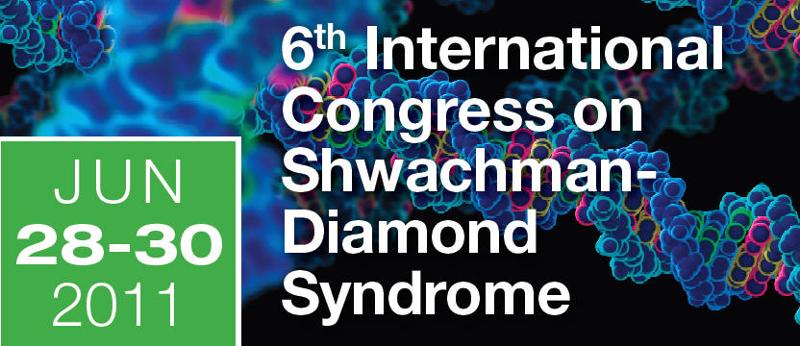
Donna Garfield, Joan Mowery and I represented SDSF at this 2 1/2 day conference on all things SDS. How wonderful it is to mingle with a group of dedicated, brilliant doctors and scientists who have not only become my heroes but also my friends. There were some SDS families attending as well and it was terrific to see familiar faces from the international support groups as well as some new faces from the USA and UK. A gigantic thank you goes to our sponsor to the prestigious New York Academy of Sciences and co-chair of the conference, Dr. Sridhar Mani, an uncle of an SDS patient, and a generous and dedicated man to not only his family but to the SDS community at large. Another gigantic thank you goes to Dr. Johnson Liu, the other co-chair who helped lead the committee responsible for inviting the presenters, creating the agenda and finding funding for the event. Other committee members who gave of their time and expertise were Dr. Elizabeth Kerr, Dr. Jeff LIpton, Dr. Outie Makitie, Dr. Johanna Rommens, Dr. Akiko Shimamura and Dr. Alan Warren. Thank you to all of them!!! The meeting was broken down in to 8 major categories: Clinical Features of SDS; Surveillance, Management and Treatment of SDS; International SDS Registries; Genetics and Disease Models of SDS; SBDS (the name of the gene-Shwachman Bodian Diamond Syndrome) Function; SBDS in Hemetopoiesis and Leukemia; Organ Development & Failure; Novel Diagnostics and Therapeutics. You can read all of the abstracts presented at this link The New York Academy of Sciences will be publishing a summary of the Congress in September and we will post it our our SDSF web site as soon as it is available. There was a also poster session at the end of each day of presentations. Read more about them here (click on the PDF "poster abstracts" that you see on the web page http://www.nyas.org/Events/Detail.aspx?cid=70e5206a-db99-47bb-af0f-444b814de403 |
|
The Turkely Family Story
|  Cason Turkely Our SDS journey began 2 ½ years ago with the New Years Eve birth of our second child, Cason. His older sister was 4 ½ when he was born and all of us were very excited to welcome baby brother into our family. He spent a few days in the NICU after birth with fluid in his lungs but once he got that taken care of, he was able to come home. He was much fussier and slept much less than his big sister had but I didn't really think too much of it for the first several months. As typical with many SDS kids, he started to fall of the weight curve between 6-8 months of age. He had only started at the 3rd percentile anyway so when he started falling off that, doctors started to take notice. Over the next 6 months, he was hospitalized twice for pneumonia and put on countless rounds of antibiotics and inhaled steroids with a nebulizer. He also continued to fall off the weight curve despite the fact that he was now eating solid foods. He was having many large, foul diapers each day and his liver counts were elevated as well. We started to realize that all of his issues amounted to much more than just a fussy baby. It is a horrible feeling to know there is something seriously wrong with your baby and not know what it is or what to do about it to help him. Doctors started talking about failure to thrive and the possibility of severe food allergies. We had him tested him for allergies, Cystic Fibrosis, Diabetes, GI issues, lung disease, heart disease, liver failure, you name it, he was tested for it. After his 3rd bout of pneumonia in 18 months and another scary ambulance ride to the ER for breathing issues, we were getting to the point where we needed answers. All of the tests he underwent were invasive, expensive, hugely stressful and revealed nothing towards a diagnosis. We were getting very frustrated with the whole process and not coming any closer to answers. I will also say that that year was the hardest on my marriage of 13 years. Constant guessing, thinking about this or that scary, terrible disease, trips to the hospital, taking time off work for a sick baby, mounting medical bills, all of which contributed to a HUGE amount of stress for both my husband and I. The worst part was not knowing what was wrong. The team of doctors we had assembled at the local Children's Hospital were a bit baffled as well. They suggested that we retest for CF since that was the most likely explanation for the majority of his symptoms. After a second negative sweat test, we were back again to an even more frustrating square one. A friend of mine called me and said that she had been researching some on her own and found something in her search about negative sweat tests and what else could be going on. She was the first person that ever mentioned Shwachman Diamond Syndrome to me. My husband and I did some research on it and it seemed a likely possible fit for Cason's symptoms. A few days later, we had another follow up appointment with the hepatologist and SDS was on my list of questions to ask her about. It was at that meeting that she brought it up to me as a possibility as well. We decided to do genetic testing for SDS and forgo the liver biopsy we had scheduled. I met with the social worker on call who came in to check on my mental health and see how we were all dealing with things. As she was asking, I burst into tears and said, "Well, I guess you can see how my mental health is holding up through all of this." She suggested that we think about family counseling. I was honest with her and said that with all the appointments we had to have and everything we were trying to keep up with, adding another appointment for mental health was just not going to happen at this point. But she did have a good point. My older daughter had gone through a serious germ-phobic phase after all of Cason's struggles that I had to discuss with the school psychologist. My husband and I were not in a good place in our marriage. I was in tears often over the whole situation. I do think that some counseling would have benefitted us all. We just simply didn't have the time, energy or resources for one more thing just then. We started pancreatic enzyme supplements then, as the hepatologist was pretty sure about pancreatic insufficiency by that point. The enzymes started making a difference in just a few days. Finally, something we could do to help him feel better and begin digesting the fat he was missing despite the high calorie diet we had had him on for months. We got the genetic test back that confirmed an SDS diagnosis about a week before Thanksgiving. I remember being so relieved to finally have something definitive to go on. I had been avoiding phone calls from friends and family for a long while because I just didn't know what to say to anyone. It took me about a week of processing before I sent out a mass email explaining what we had been through over the past almost 2 years. I attached a link to the SDS foundation for people to check out if they wanted to. I thanked everyone for the amazing, constant support they had shown us throughout the process and said, please don't call me for a while. I just need some time. We pulled Cason out of daycare. My mom came out to stay with him between Thanksgiving and Christmas break so I could have some time to research home care before the new year started. I joined an online support group for parents of SDS kids that has been amazingly informative, helpful and reassuring. It really helps to connect with a community of people who know what you have been going through and can guide you as you encounter new obstacles and celebrate with you as miracles happen along the journey. We registered him in the SDS registry and the Neutropenia registry in hopes that our story can contribute to the continued search for understanding and research about SDS. I would say at this point, that we are coming to terms with what we may face as Cason grows and new things that could develop for him. He is in a much better place than he was last fall. He is starting to grow, taking his meds, getting routine CBC's and bone marrow biopsies to help us track blood and bone marrow changes. Our team of doctors knows what they are dealing with and are doing that they can to stay on top of his situation. We are all in a place now where we realize that his future is uncertain. As a result, we are focusing much more energy on things that matter and a lot less on things that don't. Hugs and bedtime stories are much more important than dishes and laundry. I am learning more every day about how to help him and my binder of test results, doctor's visit notes and resources is filling up quickly. We plan to attend Camp Sunshine next summer and connect with other families dealing with life with SDS. In a situation where you really have no control over what is happening or what this all may develop into, I have found that knowledge is the only power I seem to have over any of it. Learning about SDS is contributing to my understanding and my mental health in very positive ways. We still have much to learn and a long journey ahead of us but I have adopted a mantra that has helped me and will continue to help me, my son and my family along the way. Celebrate the good days. Survive the bad days. Keep getting out of bed and be grateful for each and every joy life brings you along the way. |
|
 |

|
SDSF Important Links:
|
Receive Hospital Care Basket (Angel Anna Basket)
Participate in Research
Click here to see the clinical trials being conducted as registered by the NIH
 SDS REGISTRY WEB SITE CONTACTS: PRINICIPAL INVESTIGATOR: Dr. Akiko Shimamura, Seattle Registry Coordinator Satabdi Chakrabarti
-call her to join registry, ask questions and discuss registry issues.
schakrab@fhcrc.org
Shwachman-Diamond Syndrome Registry
Fred Hutchinson Cancer Research Center
206-543-9749 ADVISORY COMMITTEE Dr. Johanna Rommens, PhD Dr. Monica Bessler MD PhD Dr. Jeffrey Lipton MD SCIENTIFIC COMMITTEE
Dan Link MD
Soheil Meshinchi MD
Kathy Sakamoto MD
Sam Kocoshis MD LAY REPRESENTATIVES (appointed by the SDS Registry Advisory Committee)-email these reps with any questions or comments you may have to relay to the Registry Matt Palmer PhD- former member of the SDSF Board of Directors- mpalmer@bidmc.harvard.edu Mary Lionberger COMMUNICATE WITH OTHER FAMILIES in 2 ways: 1. Ask and Share personal, patient specific questions to other parents who may have just gone through what you are going through on the "List" which we are now calling The Sharing Link and
2. for more public sharing of your SDS experience, click on the link below to our new, official Facebook page! Feel free to upload pictures of your kids, families, stories, videos, anything!!

www.shwachman-diamond.org
Check out our new
POST YOUR FUNDRAISER web page and fundraising widget
CLICK ON
COMMUNITY FUNDRAISING
and you will see the
POST YOUR FUNDRAISER page
The fundraising widget is still being developed and will be posted soon. It will look similar to the image below.
Of course, the widget will be able to be personalized. You just send in your fundraising info and a picture of whatever you feel is appropriate to the fundraiser and SDSF will post it on the web site for all of your friends and family to see and be able to easily donate right there!
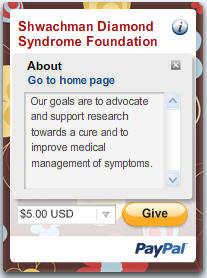
|
|
|
|
Genetic Alliance Information on Transition from Adolescence to Adult Care
| 
A new clinical report-Supporting the Health Care Transition from Adolescence to Adulthood in the Medical Home-appears in the July issue of Pediatrics. The report is jointly authored by the American Academy of Pediatrics (AAP), the American Academy of Family Physicians (AAFP), and the American College of Physicians (ACP) and the provides practical, detailed guidance on how to plan and execute better health care transitions for all patients.
Abstract
Optimal health care is achieved when each person, at every age, receives medically and developmentally appropriate care. The goal of a planned health care transition is to maximize lifelong functioning and well-being for all youth, including those who have special health care needs and those who do not. This process includes ensuring that high-quality, developmentally appropriate health care services are available in an uninterrupted manner as the person moves from adolescence to adulthood. A well-timed transition from child- to adult-oriented health care is specific to each person and ideally occurs between the ages of 18 and 21 years. Coordination of patient, family, and provider responsibilities enables youth to optimize their ability to assume adult roles and activities. This clinical report represents expert opinion and consensus on the practice-based implementation of transition for all youth beginning in early adolescence. It provides a structure for training and continuing education to further understanding of the nature of adolescent transition and how best to support it. Primary care physicians, nurse practitioners, and physician assistants, as well as medical subspecialists, are encouraged to adopt these materials and make this process specific to their settings and populations.
To link to the full clinical report, please click here. For a direct link to the algorithm that is included in the clinical report,, please click here.
Another interesting web site to check out is
Got Transition
Got Transition: New National Health Care Transition Center
Got Transition is the new National Health Care Transition Center supporting optimal transitions for youth from pediatric to adult models of care and their seamless transfer to adult health care settings. Got Transition will facilitate the implementation and dissemination of health care transition best practices in primary care medical homes and specialty settings, particularly for those youth and young adults with special health care needs. Got Transition is leading health care transition learning collaboratives with pediatric and adult practices in Washington DC, Denver, and Boston. Teams of physicians care coordinators, and consumer youth and family members are implementing the Got Transition Six Core Elements of Health Care Transition a health care transition toolkitinformed by the July 2011 AAP/AAFP/ACP clinical report. Teams are testing practice changes for their effectiveness and practicality to identify feasible improvement strategies.
For more information about Got Transition contact ann.walls@gottransition.org, visit the Got Transition Web site, or follow Got Transition on Facebook.
|
|
Simplifying Care -by Joan Mowery
| 
One of the main concerns of every SDS parent is ensuring that their child gets the best medical care available. Many of us also spend a lot of time and energy collecting and keeping medical records, so we can distribute them to all of the physicians our children are seeing as well as to the SDS Registry. Both of these tasks are daunting. Here are a few ideas that may help both issues.
If you live near, or are willing to travel to, a medical center where there are experts in the care of SDS patients, SDSF recommends that you try to get to one. At each center, you make an appointment for one specialty and the clinic will make the rest of the specialty appointsment for you while you are there. At present time, these centers are in New York (Dr. Jeff Lipton-hematology), Boston (Dr. Colin Sieff- hematology), Philadelphia (Dr. Monica Bessler-hematology), Cincinnati (Dr. Richard Harris and Dr. Stella Davies), Toronto (Dr. Peter Durie(GI) and Dr. Yigal Dror (Hematology)) and Seattle (Dr. Akiko Shimamura). Check out our Doctor Database web page for more details on these centers. Many families travel great distances to consult with these specialists. These SDS experts will then often draw up a patient care plan for the patient to take home to their own physicians who routinely follow them. This can make it easy for managing record keeping and easy for getting your records to the SDS Registry.
But what do you do if you can't travel to one of these centers?
Often where we get our medical care is determined by the kind of health insurance we have. In some cases, the health insurer may even dictate who we see for medical care. When a patient has a rare disease, this can be especially challenging.
Typically, private practice physicians do not have the time to devote to patients with complex medical issues. They have to see a certain number of patients a day, simply to cover their expenses and make a living. That is simply a fact of life. Therefore, they may not, even if they wish they could, have the time to devote to a patient with complex medical issues. In addition, I have had many physicians tell me that they simply do not have the time to read all of the medical journals that are published to stay current on all diseases.
You might find it valuable to inquire at the closest teaching medical facility to see if they have physicians on staff who know about SDS. In some cases, even though they may not know about SDS specifically, they may have experience with one or more of the 8 other BMF diseases. These physicians are typically not as time restricted in providing medical care. These facilities also have physicians on staff in all medical specialties.
Another advantage to centering all of the SDS health care in one medical center is access and exchange of medical records between the medical specialist providing your child's care and your primary physician. More and more medical centers are using computerized medical records that are instantly available to all physicians on staff.
If that option is also not available to you, then find physicians who are willing to work with you and listen to you. It is imperative that there be good communication between you and the physician. You are the person who is with your child 24/7 and you know them better than anyone.
|
ONGOING FUN FUNDRAISING IDEAS
| |
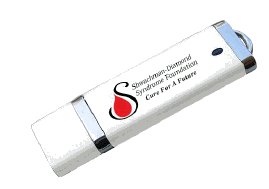 In an effort to increase awareness of Shwachman Diamond Syndrome and fund ongoing research and family support I am conducting a flash drive fundraiser. All funds raised will be donated to the Shwachman Diamond Syndrome foundation. The flash drives sell for $15.00 and are 2GB, the perfect size to hold family medical records, or schoolwork for your budding scholar. Order one for yourself, or many to resell! In an effort to increase awareness of Shwachman Diamond Syndrome and fund ongoing research and family support I am conducting a flash drive fundraiser. All funds raised will be donated to the Shwachman Diamond Syndrome foundation. The flash drives sell for $15.00 and are 2GB, the perfect size to hold family medical records, or schoolwork for your budding scholar. Order one for yourself, or many to resell!
To place an order simply send me an email letting me know how many flashdrives you would like. Payment can be made through our Donate button on the SDSF website
You can also send a check to:
SDSF
127 Western Ave,
Sherborn, MA 01770
If the purchase is made in honor of a particular person, please let us know so that we can note it in the next newsletter.
For more information contact:
Donna Garfield, SDSF Board member
dkgarfield@verizon.net
703-731-7889
RECYCLE YOUR OLD CELL PHONES by Joan Mowery
How many old cellphones are lying around your house and your family, co-workers and friends' houses???
We have a way that you can help the ecosystem and help SDSF at the same time. And we can all do it. 
It's an easy way that everyone can help raise money to support research and all of the other work SDSF does.....recycle cellphones.
SDSF has been registered with www.recyclingfundraiser.com
Start a recycling campaign by contacting family, co-workers and friends. When you have collected the cellphones go to this company's website.
They will give you instructions on how to download and print a FREE shipping label.
To make sure SDSF gets a check for your shipment make sure to put the SDSF return address on the shipping label.
Shwachman-Diamond Syndrome Foundation
127 Western Ave.
Sherborn, MA 01770
This is easy-has no cost to you--and most importantly will help SDSF continue it's work to help our kids.
PLEASE START THIS CAMPAIGN TODAY. Please contact Joan Mowery with questions
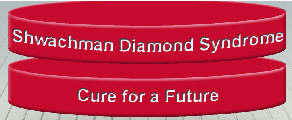 SDS Rubber Bracelets can be bought through SDSF SDS Rubber Bracelets can be bought through SDSF
and sold at any of these events below. We sell them for 10 @$25.00 and you can re-sell for whatever you feel your market will bear. If you need a large quantity, we will negotiate the price depending on the number needed.
|
|
CAN YOU SEND IN TISSUE? BLOOD? PATIENT INFORMATION?
| SDSF has a long history of many families participating in different studies that researchers are working on and who need tissue, blood or information of an affected SDS patient. There is no listing now but please check back here frequently as this listing may change. Of course, the SDS Registry is always in need of updated patient information and tissue and blood samples. Please go to the SDS Registry web site for more information on how to do this.
Also, you can click here to see what the registered-by-NIH clinical trials are at this time : http://clinicaltrials.gov/ct2/results?term=shwachman
|
|
THANK YOU FOR YOUR DONATIONS (April 1, 2011 - July 25, 2011)
| |
IBM Employee Services Center
Jeffrey Kohn
Mr. & Mrs. John Wall
Gail Kohn
Rebecca Best
Southeastern Michigan Area CFC
Monadnock United Way
United Way of Rhode Island
In Honor of Gracie Van Brunt - Gracie Fund
In Honor of Logan Stone - Susan & Curt Utz
In Honor of Emily & Kelsey Jenuwine - Center Line Lions Club
In Honor of Sarah Kilby:
Mike Kelly, Stephanie Norris, Kim Bishop, James Finucane,
Ralph Laudait, Linda Anderson, Patrick Reilly, Patrick Consedine
Kevin Handzel, Paul Dolan, Sean Finucane, William Collings,
Debra King, Mary Contino, Agnes Beaulieu, Millie Cassidy
Matt Santos, Patricia Landry, Brian Lyman, Ersson Zapata
Louis Paciello, Robert & Louise Raspallo, Penn London Elementary School
Kathleen Grugan, Susan & Glenn Lewis, Carolyn Buckfeller, Thomas & Chreyl Kenton
Nancy Murphy, Lawrence & Donna Small
In Memory of Harriott Hughes - Christine James & Danielle Fletcher
|
|
WELCOME NEW SDS FAMILIES!! |
Cambridge, MN
Canoga Park, GA
Lenexa, KS
Ridgwood, NJ
Omaha, NE
San Antonio, TX
Chicago, IL
Union Beach, NJ
Lanoka Harbor, NJ
Ray City, GA
Mickelton, NJ
Bloomington, IN
Nashville, IN
Cheshire, OH
Red Bluff, GA |
 Shwachman-Diamond Syndrome Foundation Shwachman-Diamond Syndrome Foundation
| |
FOUNDER: Joan Mowery 1994
BOARD OF DIRECTORS
Blair Van Brunt -President Bryan Sample - Treasurer Donna Garfield - Newsletter
Ed Bickel - Special Programs
Other Amazing Leaders
Joan Mowery - Family Follow Up
Jane Fitz - Anna Angel Basket Coordinator
Kim McDowell - Administrative Assistant
ATTORNEY: Ann Bodewes Stephens, Herzog Crebs
BOOKEEPER: Letitia Cote, Quickbooks Advanced Certified Proadvisor
|
|
|
|
Shwachman Diamond Syndrome Foundation
127 Western Avenue
Sherborn, MA 01770
1-888-825-SDSF (7373)
www.shwachman-diamond.org
info@shwachman-diamond.org
|
|
|
|
|
|